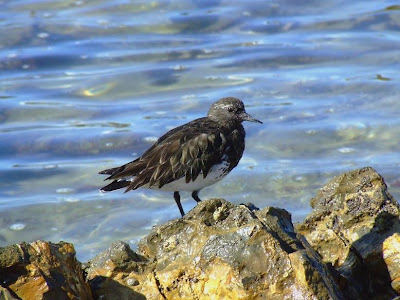
For me, new birds for my life list have become increasingly tough to find. I enjoy county listing, state listing, Bigbying, and other listing games, but I've found it really fun getting to know the local herps, butterflies, and plants. I don't go out actively seeking these things, but I keep an eye out for them while birding. Today, I found two lifers, but not of the avian variety.
This afternoon, while taking a short hike around some of the wilder areas of Irvine Regional Park, I found several small, dark butterflies (pictured above) flitting around despite the cloud cover and cool temperatures. They seemed vaguely familiar - I browse through my butterfly book occasionally - but I didn't know what they were. I was able to get some good photos of one of them by lying down in the middle of the trail (good thing no one came by while I was photographing the butterfly!). When I got home, I identified them as Mormon Metalmarks (Apodemia mormo). A butterfly species for me, and the first metalmark of any kind I've ever seen.
A few minutes later, I spotted an enormous snake stretched almost completely across the trail. I checked through binoculars to see if it was a rattlesnake - it wasn't, so I advanced closer. It was a very large snake - at least four feet long! It wasn't at all willing to pose for photos, and quickly slithered off into the brush. I'm no expert on snakes, but I believe it is a Gopher Snake (Pituophis catenifer). Please correct me if I'm wrong! If it is a Gopher Snake, it is a life herp for me.

By now you may be wondering what's wrong with me - I haven't talked about any of the birds I saw! There were few. Most seemed to be hunkered down out of the wind and cool temperatures. However, I found the Lewis's Woodpecker sitting down low in its favorite tree, giving good looks. An odd thumping sound emanating from a hollow tree near the lake turned out to be a White-breasted Nuthatch working on its nest cavity. Every now and then it would poke its head out of the crack, but I only caught the bill.

Yesterday afternoon, my dad and I were up in the vicinity of Brea, so we swung by Carbon Canyon Regional Park. I'd never been there before. We didn't see very many birds, probably due to the time of day, the crowds of people, and the wind. There is lots of scrub along a dry creek bed and some tall pines that look promising, so I'll definitely be visiting again. A pair of egrets - one Snowy and one Great Egret - were loafing in the shade of a tree overhanging the lake. This gave me the opportunity to finally get some egret photos that aren't horribly overexposed!


Lately, I've been noticing lots of birds carrying nesting material. I followed a California Towhee with a huge mouthful of dried grass to a partially-completed nest last week somewhere at Peters Canyon, and this week there was one egg in the nest.































